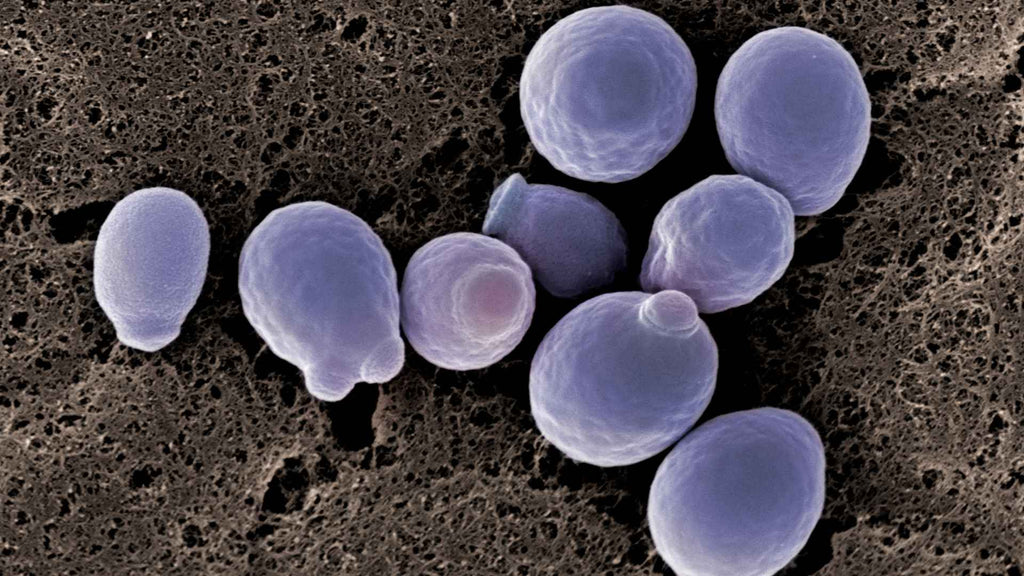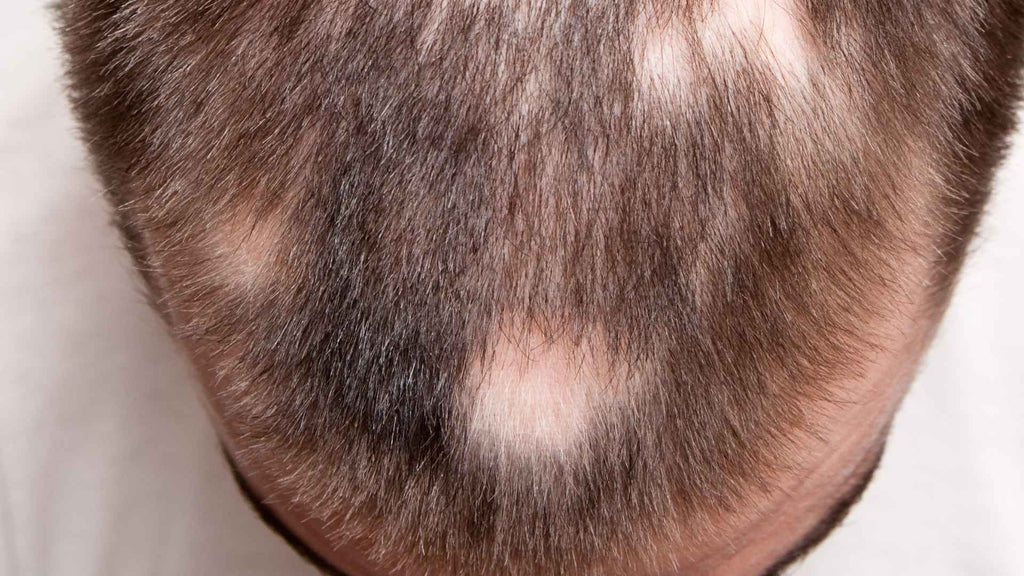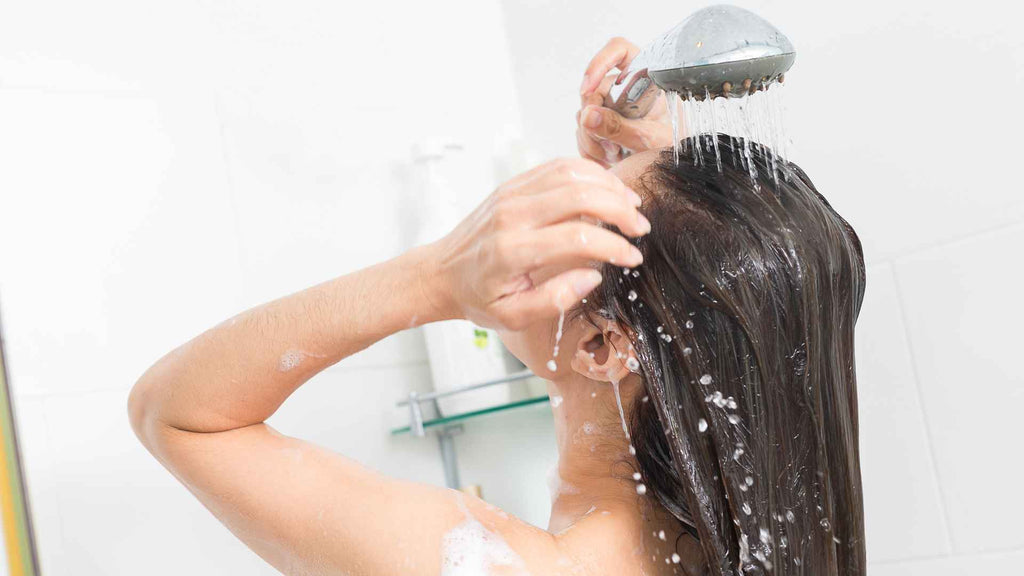Unless you're a baker making bread on your head, there really shouldn't be an overabundance of yeast on your scalp. And if you are a baker making head bread, please stop. That sounds disgusting.
If you've been scratching your head trying to figure out why you've been scratching your head, we may have the answer: it could be a scalp yeast infection.
Don't worry. You're not alone.
This condition happens more often than you think. And no, it's not just about washing your hair more.
We'll tell you how to notice symptoms early, avoid the condition, and how to get rid of it. With the right knowledge about scalp care, you can protect your scalp's ecosystem.
Keep reading to learn how to take care of your hair and scalp.
What is a scalp yeast infection?
So what exactly is a scalp yeast infection? And why is it crucial to tackle it head-on?
Essentially, it's an uncomfortable condition caused by fungi. This can occur when the environment of bacteris and yeast on the scalp becomes unbalanced. This causes scalp skin infections, and symptoms that can't be ignored if you value your scalp's health and hair. Understanding and addressing it promptly can prevent further complications, including hair loss.
These infections are due to an overgrowth of a particular strain of yeast called Candida, or Malassezia. This yeast thrives in the warm, moist conditions on your scalp.
Common symptoms include red, itchy patches, a lot of flakes and dead skin. If not treated promptly, symptoms can include hair loss. This hair loss occurs as the infection inflames and damages your hair follicles. Eventually, this could lead to noticeable bald patches. Scalp yeast infections happen for several reasons.

These include too much oil on the scalp and changes in hormones. Poor hygiene and warm, moist places can also cause these infections. To treat them and find relief, you can use antifungal shampoos and creams. Oral medications, such as fluconazole, are available too. Keeping the scalp clean is also important.
Importance of addressing it
Understanding the grave consequences of untreated scalp yeast infections highlights the necessity of prompt and effective treatment. Ignoring a scalp yeast infection can lead to severe complications, including significant hair loss. This isn't just about dealing with itchiness or unsightly red patches. It's about preventing damage to your hair follicles that can result in bald patches.
The key to avoiding such outcomes lies in early diagnosis and the use of antifungal medications. Don't wait until you're facing the dire consequences to act. A correct diagnosis through thorough examination and culture tests distinguishes a yeast infection from other scalp issues.
This, in turn, ensures the right course of treatment. Remember, addressing a scalp yeast infection promptly can save your hair and health from unnecessary complications.
Causes of scalp yeast infection
Understanding the causes of scalp yeast infections is crucial for both prevention and treatment. An excess of yeast, like Candida or Malassezia, often results from high humidity or bad hygiene. Additionally, underlying health conditions, including diabetes, can play a significant role in predisposing your scalp to these infections.
Overgrowth of yeast such as Candida or Malassezia.

Candida and Malassezia, two types of yeast, can overgrow on your scalp, triggering yeast infections. This overgrowth often leads to uncomfortable symptoms. These include itchiness and flakiness, which are telltale signs you're dealing with a yeast-related issue. If left unchecked, these infections can cause more severe problems, such as hair loss.
This occurs because the yeast can damage your hair follicles, sometimes leading to circular patches of baldness. It's crucial to understand that your immune system plays a significant role in managing these yeast populations.
Stress, illness, or poor nutrition can weaken it. Then, it can't control the growth of Candida and Malassezia well. This turns your scalp into a place where these yeasts can grow easily. As a result, you might get a scalp yeast infection.
Factors contributing to yeast overgrowth (e.g., humidity, poor hygiene).
Now let's explore what causes these yeast infections to flourish on your scalp, including environmental and personal habits. One of the primary factors contributing to yeast overgrowth is residing in warm and humid environments.
These conditions provide the perfect breeding ground for yeast, making your scalp an ideal site for infection. Additionally, poor scalp hygiene can exacerbate the issue. If you don't wash your hair often or well, you're inviting yeast to grow.
 Moist climates and poor hygiene make the perfect setting for yeast infections on the scalp. Remember, keeping your scalp clean and dry is crucial in preventing yeast overgrowth.
Moist climates and poor hygiene make the perfect setting for yeast infections on the scalp. Remember, keeping your scalp clean and dry is crucial in preventing yeast overgrowth.Relation to other health conditions (e.g., diabetes).
Certain health conditions, such as diabetes, can significantly increase your risk of developing a scalp yeast infection. If you have diabetes, your immune system may be weaker. This can make it difficult for your body to fight fungal infections. This vulnerability means you're more prone to yeast infections on your scalp.

The reason? High blood sugar levels create a breeding ground for yeast to thrive. Diabetes can cause changes in the skin. This includes more moisture and changes in pH levels. These changes increase the risk of scalp yeast infections.
Managing your diabetes effectively, through medication, diet, and lifestyle changes, is key to reducing this risk. Remember, a healthy immune system is your best defense against fungal infections.
Symptoms of a scalp yeast infection
Symptoms of a yeast infection of the scalp include scaly, bald patches. They also involve soreness and redness. If not treated, these can lead to patchy hair loss.
Understanding these signs is crucial for seeking timely treatment.
Itchy scalp
As discussed, a scalp yeast infection is primarily caused by an overgrowth of Candida or Malassezia. This type of infection creates an environment where you're constantly battling the urge to scratch.
Beyond the discomfort, this incessant itching can lead to more serious issues, including hair loss.
The reason? Scratching can damage your hair follicles, weakening them. In some cases, causing them to release their grip on your hair prematurely.
Candida or Malassezia can make your scalp itch. They also cause red, inflamed patches and white, flaky scales that irritate the scalp more.
Quickly treating the infection can lessen these symptoms. It reduces the itch and helps stop more damage to your scalp and hair.
Scaly, bald patches
You may have a yeast infection if you notice scaly, bald patches on your scalp. These patches often come with redness and itching.
These unsightly patches can be more than just an annoyance; they're a sign that something's off balance. With scalp yeast infection, you might notice flaky greasy scales amidst these bald spots, adding to the discomfort.
The itchiness isn't the only problem. The scales show there's a deeper issue. Also, the patches aren't simply smooth. They may have pimples or pustules near hair follicles. This suggests a serious infection.
So, if you're spotting these symptoms, it's crucial to address them promptly. Ignoring them won't just affect your scalp's health but could potentially lead to more hair loss.
Soreness and redness
Among the telltale signs of a scalp yeast infection, soreness and redness stand out. These indicate your scalp's battle against inflammation and irritation. These symptoms aren't just uncomfortable; they're a clear signal that yeast overgrowth is wreaking havoc beneath your hair.
Your scalp might feel very tender. It reacts sensitively when touched or while brushing your hair. This tenderness and clear redness show there is inflammation. This inflammation is a response to unwanted yeast.
It's crucial to understand that the severity of soreness and redness can vary. However, regardless of intensity, these signs shouldn't be ignored. They're your body's way of signaling that something's amiss, urging you to take action before the situation escalates.
Promptly addressing these symptoms can halt the yeast's advance, sparing you from more severe complications.
Patchy hair loss
Patchy hair loss is a key symptom of scalp yeast infections. This results from the damage and irritation to your hair follicles. This distressing effect can lead to circular patches of baldness, an infection called tinea capitis. It's the itching that really does the damage, weakening and ultimately harming your hair follicles.

Over time, if the infection isn't treated, you'll notice more hair loss as dead skin and flakes accumulate. This further blocks new hair growth. It's crucial you address scalp yeast infections promptly to avoid such complications.
Acting quickly not only helps prevent persistent hair loss but also saves your scalp from further damage. Remember, timely treatment can turn the tide, restoring your scalp's health and halting hair loss in its tracks.
Types of Scalp Yeast Infection
You might be surprised to learn that not all scalp yeast infections are the same. In fact, Tinea Capitis, or scalp ringworm, and cutaneous candidiasis highlight the variety of these infections.
Understanding the distinction between fungal and yeast infections is crucial for targeting the right treatment.
Tinea Capitis (Ringworm of the Scalp)
Tinea Capitis, also called ringworm of the scalp, is a fungal infection on your scalp's skin. It is caused by dermatophytes, not the malassezia yeast linked to dandruff. This infection can cause severe symptoms such as hair loss.

You might see bald spots where hair has broken off at the scalp. These spots can show black dots or red, scaly areas. They might be itchy or have pus-filled sores. To treat tinea capitis, you can't just use regular shampoos.
You need oral antifungal medicine from a healthcare professional. This treatment fights the infection from within. It reduces the risk of spreading it to others. It also helps prevent the condition from getting worse or coming back.
Cutaneous Candidiasis on the Scalp
Tinea capitis is a fungal infection that attacks the scalp. Meanwhile, cutaneous candidiasis is a different problem. It is a yeast infection caused by the Candida fungus. This fungus loves warm, moist places like your scalp. It can cause uncomfortable symptoms.
You'll notice red patches that may crack, alongside white, flaky scales. More distressingly, it can cause hair loss, making prompt and effective treatment crucial.
To combat this scalp yeast infection, antifungal medications are your go-to solution. These treatments, including azoles or polyenes, specifically target the Candida fungus.
These aim to restore your scalp's health and prevent further hair loss. Don't wait to address these symptoms; early intervention can shield you from lasting damage.
Distinction between fungal and yeast infections
Understanding the difference between fungal and yeast infections is key to effectively treating scalp issues. It is important to know if you have a fungal infection or yeast overgrowth on your scalp.
Many fungi can lead to infections.
However, yeast infections on the scalp usually come from Malassezia or Candida. Candida thrives in warm, moist places. It causes red, itchy patches and flakes.
Malassezia can cause seborrheic dermatitis. This condition includes greasy scales and red patches. Knowing if Malassezia or Candida is affecting you is key to picking the right treatment.
Treatment Options for Scalp Yeast Infection
When you're facing a scalp yeast infection, you've got several treatment paths to consider. There are many treatments for fungus, including over-the-counter options, prescriptions, and natural remedies. These suit various severities and preferences.
It's important to compare the benefits to the risks. For example, topical steroids can be dangerous. Safer alternatives like Dermeleve® are worth considering.
Over-the-counter (OTC) antifungal treatments
You can treat scalp yeast infections with over-the-counter antifungal products. These include shampoos and ointments. Many of these products contain Ketoconazole, Zinc pyrithione, and Selenium sulphide.
These ingredients fight yeast overgrowth on the scalp. They also help reduce itching, flaky scales, and red patches.
Antifungal shampoos mainly treat the infection and prevent future outbreaks. Always consult a healthcare provider to choose the best treatment for the severity of your infection.

They'll guide you towards the best product, ensuring you tackle the infection effectively without compromising your scalp's health.
Prescription medications (topical and oral)
Doctors often treat severe scalp yeast infections and prescribe antifungal medications. These include creams applied directly to the scalp and oral pills. The treatment is specific to the type of yeast causing the infection. Fluconazole is a common oral antifungal that's highly effective against Candida, the yeast often behind scalp issues.
Alongside, you might be recommended a ketoconazole shampoo as part of your yeast infection treatment. This powerful antifungal agent works wonders in controlling dandruff and yeast overgrowth directly on your scalp. In cases where inflammation is severe, topical corticosteroids can also be part of the treatment plan.
These medications help reduce swelling and irritation, providing much-needed relief. Follow your healthcare provider's instructions closely when using prescription medications. This is important to treat your scalp yeast infection effectively and avoid complications.
The Dangers of Topical Steroids
Topical steroids can offer quick relief from inflammation caused by scalp yeast infections. However, it's crucial to use them wisely to avoid potential risks.
Corticosteroids, though effective in reducing severe inflammation, come with their own set of complications if not managed properly. Prolonged use can lead to skin thinning and an increased susceptibility to infections.
The FDA has specifically warned against the use of medicated shampoos containing corticosteroids in young children. This underscores the importance of cautious application.
Ironically, steroids can take a long time to become effective. Often this can be days or even weeks.

Therefore, when considering topical steroids for a scalp yeast infection, it's imperative to consult with a healthcare provider.
Balancing benefits and risks ensures the right steps towards healing without causing more harm to your scalp's health.
Dermeleve® - The Safer Alternative to Topical Steroids
Dermeleve® Scalp Serum is a safer way to soothe the skin suffering from scalp yeast infections without using topical steroids. Dermeleve® uses natural ingredients to fight symptoms such as itchiness, redness, and flakiness. It doesn't have the harsh side effects that steroids do.
This new method tackles the itching sensation caused be the yeast overgrowth. It also helps create a healthy scalp by breaking the itch-scratch cycle that can prevent healing and lead to other damaging consequences.
Choosing Dermeleve® means you get a gentle but effective treatment. It provides lasting relief and takes good care of your scalp. It's a smart move for anyone prioritizing their scalp health and seeking sustainable results.
Natural remedies and their efficacy

Similarly, apple cider vinegar works by creating an acidic environment. Yeast finds this inevironment inhospitable, helping to keep the infection at bay. Lemongrass oil, with its antimicrobial prowess, further targets yeast populations, reducing their presence. While these natural remedies offer a way to alleviate symptoms, it's crucial to consult with a healthcare provider.
They can guide you towards a comprehensive treatment plan. This ensures that any scalp yeast infection that may develop is addressed effectively and safely.
Preventive Measures
It's crucial you keep that part of the body clean and dry, particularly in humid conditions. You should also avoid sharing personal items like combs and hats, as these can spread the infection.
Lastly, adopting a healthy diet and lifestyle can help prevent yeast overgrowth, keeping your scalp healthy.
Maintaining scalp hygiene
It is important to keep your scalp clean to avoid yeast infections. You should regularly wash your hair with antifungal shampoos. These shampoos clean your scalp and prevent fungal growth which can cause yeast infections.
You must have a regular hair care routine. This will keep your scalp healthy, clean, and balanced.

Strengthening your immune system through a healthy lifestyle and diet plays a vital role in preventing these infections. Your body's natural defenses can more effectively ward off the overgrowth of yeast. If you're experiencing symptoms of a scalp yeast infection, it's important to seek medical advice promptly. Early intervention can prevent the infection from worsening and protect your scalp's health.
Avoiding sharing personal items like combs and hats
It's crucial you also consider the risk of sharing personal items like combs and hats. A scalp infection caused by a yeast imbalance is contagious. The warmth and moisture these items often retain make them perfect breeding grounds for yeast. By sharing such personal items, you're not just sharing a tool but potentially spreading an infection.
Maintain optimal scalp health and prevent cross-contamination, by using your own hair care tools and accessories. This practice significantly reduces the likelihood of yeast transmission and supports your overall hygiene efforts.
Remember, keeping personal items separate is more than just a gesture of personal space. It's a proactive measure against scalp yeast infections.
Diet and lifestyle changes to prevent yeast overgrowth
Adjusting your diet and lifestyle may seem challenging. But these changes can significantly prevent the overgrowth of yeast on your scalp. Eating a balanced diet rich in fruits, vegetables, whole grains, and lean proteins helps keep yeast at bay.
Limiting sugar and refined carbs cuts down the yeast's food source, thwarting scalp yeast infection.
Staying well-hydrated maintains a healthy balance of microorganisms, further preventing yeast overgrowth. Incorporating regular exercise and stress management into your routine bolsters your immune system, reducing the risk of infections.
Moreover, avoid harsh hair products that can disrupt your scalp's natural balance. This is crucial for preventing yeast overgrowth and maintaining scalp health. These lifestyle changes are key in keeping your scalp healthy and free from yeast infections.
Conclusion
It is important to know why scalp yeast infections happen, the symptoms, and how to treat them. This knowledge helps prevent possible hair loss and keeps the scalp healthy. These infections, driven by factors like excessive oil production and warm, humid environments, can lead to troubling symptoms if left untreated.
You might notice itchy, red patches or flaky white scales. If not treated, these can cause discomfort and risk of hair loss. They tend to damage hair follicles.
To combat these infections, antifungal treatments emerge as a cornerstone strategy. Shampoos, ointments, and foams are treatments that stop yeast growth. They ease symptoms and prevent problems.
Not treating can cause serious issues. These include ongoing hair loss and more scalp damage. This is especially true if you have conditions like hypothyroidism.
To wrap up, remember that a healthy scalp is the root to luscious locks – so don't let those pesky yeasts rain on your parade!
Embrace your scalp's journey to greatness with a sprinkle of antifungal magic. For more tips and tricks, hop on over to www.dermeleve.com and let's show those yeasts who's boss!
Frequently Asked Questions
How Do You Get Rid of Yeast on Your Scalp?
To tackle yeast on your scalp, use antifungal shampoos and consider corticosteroids for severe cases. Consult a doctor for prescriptions if needed. Maintain scalp hygiene and don't share personal items like combs or hats.
How Do I Know if I Have a Fungal Infection on My Scalp?
You might think it's just dandruff, but if you're noticing itchy, red patches, flaky white scales, and hair loss, you could have a fungal infection. Pay attention to these signs for proper diagnosis and treatment.
What Kills Scalp Fungus Fast?
To quickly kill scalp fungus, you'll want to use antifungal shampoos with ingredients like Ketoconazole or try natural remedies like tea tree oil. Severe cases might require oral medications or prescription-strength creams for rapid relief.
Does Apple Cider Vinegar Destroy Scalp Fungus?
Yes, apple cider vinegar can destroy scalp fungus quickly. Its antifungal properties and acidic nature create an environment where fungus can't thrive, reducing itching and inflammation when used regularly as a diluted scalp rinse.




